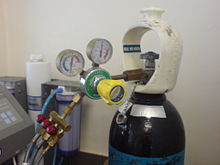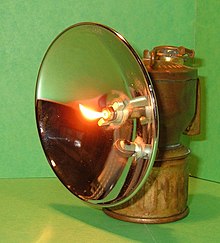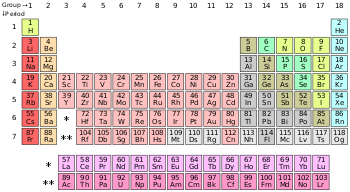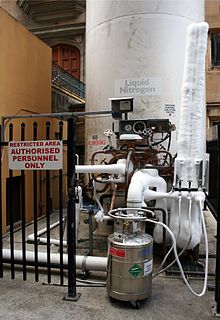Industrial gas: Difference between revisions
| Line 52: | Line 52: | ||
=== Distribution === |
=== Distribution === |
||
[[Image:Compressed hydrogen tube trailer.jpg|thumb|right|[[Compressed hydrogen]] tube trailer ]] |
[[Image:Compressed hydrogen tube trailer.jpg|thumb|right|[[Compressed hydrogen]] tube trailer ]] |
||
Most gases are supplied as compressed gas. A [[gas compressor]] is used to compress the gas into storage [[pressure vessels]] (such as cylinders or [[Compressed hydrogen tube trailer|tube trailers]]) through distribution systems. However a few gases are [[vapour]]s that can be liquefied at [[ambient temperature]] under [[pressure]] alone. This includes the significant industrial gases chlorine, ammonia, propane, butane and sulphur dioxide, as well as carbon dioxide and nitrous oxide |
Most gases are supplied as compressed gas. A [[gas compressor]] is used to compress the gas into storage [[pressure vessels]] (such as cylinders or [[Compressed hydrogen tube trailer|tube trailers]]) through distribution systems. <br /> |
||
However a few gases are [[vapour]]s that can be liquefied at [[ambient temperature]] under [[pressure]] alone. This includes the significant industrial gases chlorine, ammonia, propane, butane and sulphur dioxide, as well as carbon dioxide and nitrous oxide. These last two can only be liquefied under pressure if kept below their [[Critical point (thermodynamics)|critical temperatures]] (31°C for CO<sub>2</sub> and 36°C for N<sub>2</sub>O). This [[Phase transition|phase change]] makes all of them useful as [[refrigerants]] (except chlorine which is too toxic, corrosive and reactive to ever have been used as a refrigerant). In practice, all of these substances are ''Gas'' (not vapor) at the 200 [[bar (unit)|bar]] pressure in a gas cylinder because that pressure is above their [[Critical point (thermodynamics)|critical pressure]].<br /> |
|||
Other gases can only be supplied as liquid if also refrigerated; exceptionally [[carbon dioxide]] can be produced as the cold [[solid]] [[dry ice]]. |
|||
The major industrial gases can be produced in bulk and delivered to customers by [[pipeline transport|pipeline]], but can also be packaged and transported. |
The major industrial gases can be produced in bulk and delivered to customers by [[pipeline transport|pipeline]], but can also be packaged and transported. |
||
Revision as of 11:13, 24 January 2014

Industrial gases are a group of gases that are specifically manufactured for use in a wide range of industries; which include oil and gas, petrochemicals, chemicals, power, mining, steelmaking, metals, environmental protection, medicine, pharmaceuticals, biotechnology, food, water, fertilizers, nuclear power, electronics and aerospace.
The principal gases provided are nitrogen, oxygen, carbon dioxide, argon, hydrogen, helium and acetylene; although a huge variety of gases and mixtures are available in gas cylinders. The industry producing these gases is known as the Industrial Gases industry[1] and is a part of the wider Chemical Industry (where industrial gases are often seen as "speciality chemicals").
Whilst a few products are available for sale to or use by the population at large (for example balloon helium and medical oxygen), most are sold to other industrial enterprises.
Early History

The first gas used by man from the natural environment was almost certainly air when it was discovered that blowing on or fanning a fire made it burn brighter. The warm gases from a fire could be used to smoke food. Cooking with water would have produced steam which could also have been used to cook some foods more slowly. Carbon dioxide would have been known as the byproduct of fermentation, particularly for beverages, which was first documented dating from 7000–6600 BCE in Jiahu, China.[2] Natural gas was used by the Chinese in about 500 B.C. when they discovered the potential to transport gas seeping from the ground in crude pipelines of bamboo to where it was used to boil sea water.[3] Sulfur dioxide was first used by the Romans in winemaking when it was discovered that if you burn candles made of sulfur inside empty wine vessels it would keep them fresh and prevent them gaining a vinegar smell.[4]


However until the advent of scientific method[5] and the science of chemistry, none of these gases would have been positively identified or understood. The history of chemistry tells us that a number of gases were identified and either discovered or first made in relatively pure form during the Industrial Revolution of the 18th and 19th centuries by notable chemists in their laboratories. The timeline of attributed discovery for various gases are carbon dioxide (1754)[6] , hydrogen (1766),[7] nitrogen (1772), nitrous oxide (1772), oxygen (1773)[8][9] , ammonia (1774), chlorine (1774),[10] methane (1776), hydrogen sulfide (1777), carbon monoxide (1800), hydrogen chloride (1810), acetylene (1836), helium (1868), fluorine (1886), argon (1894), krypton, neon and xenon (1898)[11] and radon (1900).
Carbon dioxide, hydrogen, nitrous oxide, oxygen, ammonia, chlorine, sulfur dioxide and manufactured fuel gas were already being used during the 19th century, and mainly had uses in food, refrigeration, medicine, and for fuel and gas lighting.[12] For example, carbonated water was being made from 1772 and commercially from 1783, chlorine was first used to bleach textiles in 1785 [13] and nitrous oxide was first used for dentistry anaethesia in 1844. At this time gases were often generated for immediate use. A notable example of a generator is Kipps apparatus which was invented in 1844 [14] and could be used to generate gases such as hydrogen, hydrogen sulfide, chlorine, acetylene and carbon dioxide by simple chemical reactions. Acetylene was manufactured commercially from 1893 and acetylene generators were used from about 1898 to produce gas for gas cooking and gas lighting, however electricity took over as more practical for lighting and once LPG was produced commercially from 1912, the use of acetylene for cooking declined.[12]
Once gases had been discovered and produced in modest quantities, the process of industrialisation spurred on innovation and invention of technology to produce larger quantities of these gases. Notable developments in the industrial production of gases include the electrolysis of water to produce hydrogen (in 1869) and oxygen (from 1888), the Brin process for oxygen production which was invented in the 1884, the chloralkali process to produce chlorine in 1892 and the Haber Process to produce ammonia in 1908.[15]
The development of uses in refrigeration also enabled advances in air conditioning and the liquefaction of gases. Carbon dioxide was first liquefied in 1823. The first Vapor-compression refrigeration cycle using ether was invented in 1834 and a similar cycle using ammonia was invented in 1873 and another with sulfur dioxide in 1876.[12] Liquid oxygen and Liquid nitrogen were both first made in 1883; Liquid hydrogen was first made in 1898 and liquid helium in 1908. LPG was first made in 1910. A patent for LNG was filed in 1914 and the first commercial production was in 1917.[16]
Although no one event marks the beginning of the industrial gas industry, many would take it to be the 1880s with the construction of the first high pressure gas cylinders.[12] Initially cylinders were mostly used for carbon dioxide in carbonation or dispensing of beverages. In 1895 refrigeration compression cycles were further developed to enable the liquefaction of air,[17] most notably by Carl von Linde [18] allowing larger quantities of oxygen production and in 1896 the discovery that large quantities of acetylene could be dissolved in acetone and rendered nonexplosive allowed the safe bottling of acetylene.[19]
A particularly important use was the development of welding and metal cutting done with oxygen and acetylene from the early 1900s. As production processes for other gases were developed many more gases came to be sold in cylinders without the need for a gas generator.
Technology

Air separation plants refine air in a separation process and so allow the bulk production of nitrogen and argon in addition to oxygen - these three are often also produced as cryogenic liquid. To achieve the required low distillation temperatures, an Air Separation Unit (ASU) uses a refrigeration cycle that operates by means of the Joule–Thomson effect. In addition to the main air gases, air separation is also the only practical source for production of the rare noble gases neon, krypton and xenon.
Cryogenic technologies also allow the liquefaction of natural gas, hydrogen and helium. In natural-gas processing, cryogenic technologies are used to remove nitrogen from natural gas in a Nitrogen Rejection Unit; a process that can also be used to produce helium from natural gas - if the natural gas fields contain sufficient helium to make this economic. The larger industrial gas companies have often invested in extensive patent libraries in all fields of their business, but particularly in cryogenics.
The other principal production technology in the industry is Reforming. Steam reforming is a chemical process used to convert natural gas and steam into a syngas containing hydrogen and carbon monoxide with carbon dioxide as a byproduct. Partial oxidation and autothermal reforming are similar processes but these also require oxygen from an ASU. Synthesis gas is often a precursor to the chemical synthesis of ammonia or methanol. The carbon dioxide produced is an acid gas and is usually removed by amine treating; the separated carbon dioxide can then be diverted to a carbon capture reservoir.
Air Separation and Hydrogen Reforming technologies are the cornerstone of the industrial gases industry and also form part of the technologies required for many fuel gasification ( including IGCC), cogeneration and gas to liquids schemes. Hydrogen has many production methods and is touted as a carbon neutral alternative fuel to hydrocarbons, whilst liquid hydrogen is used by NASA in the Space Shuttle as a rocket fuel; see hydrogen economy for more information on hydrogens uses.
Simpler gas separation technologies, such as membranes or molecular sieves used in pressure swing adsorption or vacuum swing adsorption are also used to produce low purity air gases in nitrogen generators and oxygen plants. Other examples producing smaller amounts of gas are chemical oxygen generators or oxygen concentrators.
In addition to the major gases produced by air separation and syngas reforming, the industry provides many other gases. These are produced in much smaller quantities than the major gases by a variety of processes; for example, hydrogen chloride is produced by burning hydrogen in chlorine, nitrous oxide is produced by gently heating ammonium nitrate and electrolysis is used for the production of fluorine. Since fluorine is highly reactive, industrial chemistry requiring fluorine often uses hydrogen fluoride (or hydrofluoric acid) instead. Another approach to this is to generate gas as and when required, which is done, for example, with ozone. Some gases are simply byproducts from other industries and others are sometimes bought from other larger chemical producers, refined and repackaged.
Related services and technology can be supplied such as refrigeration, air purifiers and compressed air; as well as vacuum, which is often provided in hospital gas systems. Another unusual system is the inert gas generator. Some industrial gas companies may also supply related chemicals, particularly liquids such as bromine and ethylene oxide.
Distribution

Most gases are supplied as compressed gas. A gas compressor is used to compress the gas into storage pressure vessels (such as cylinders or tube trailers) through distribution systems.
However a few gases are vapours that can be liquefied at ambient temperature under pressure alone. This includes the significant industrial gases chlorine, ammonia, propane, butane and sulphur dioxide, as well as carbon dioxide and nitrous oxide. These last two can only be liquefied under pressure if kept below their critical temperatures (31°C for CO2 and 36°C for N2O). This phase change makes all of them useful as refrigerants (except chlorine which is too toxic, corrosive and reactive to ever have been used as a refrigerant). In practice, all of these substances are Gas (not vapor) at the 200 bar pressure in a gas cylinder because that pressure is above their critical pressure.
Other gases can only be supplied as liquid if also refrigerated; exceptionally carbon dioxide can be produced as the cold solid dry ice.
The major industrial gases can be produced in bulk and delivered to customers by pipeline, but can also be packaged and transported. Most gases are sold in gas cylinders and some sold as liquid in appropriate containers (e.g. dewars) or as bulk liquid delivered by truck. The industry originally supplied gases in cylinders to avoid the need for local gas generation; but for large customers such as steelworks or oil refineries, a large gas production plant may be built nearby (typically called an "on-site" facility) to avoid using large numbers of cylinders manifolded together. Alternatively, an industrial gas company may supply the plant and equipment to produce the gas rather than the gas itself. An industrial gas company may also offer to act as plant operator under an operations and maintenance contract for a gases facility for a customer, since it usually has the experience of running such facilities for the production or handling of gases for itself.
The delivery options are therefore:
- Local gas generation
- Pipelines
- Bulk transport (truck, rail, ship)
- Packaged gases in gas cylinders or other containers
What defines an Industrial gas
Industrial gas is a group of gases that are specifically manufactured for use in industry. They are chemicals which can be an elemental gas or a chemical compound that is either organic or inorganic, which tend to be low molecular weight molecules. They could also be a mixture of such gases. They have value as a chemical; whether as a feedstock, in process enhancement, as a useful end product, or for a particular use; as opposed to having value as a "simple" fuel.
The term “industrial gases” [20] is sometimes narrowly defined as just the major gases sold, which are: nitrogen, oxygen, carbon dioxide, argon, hydrogen, acetylene and helium.[21] Many names are given to gases outside of this main list by the different industrial gas companies, but generally the gases fall into the categories "specialty gases", “medical gases”, “fuel gases” or “refrigerant gases”. However gases can also be known by their uses or industries that they serve, hence "welding gases" or "breathing gases", etc. ; or by their source, as in "air gases"; or by their mode of supply as in "packaged gases". The major gases might also be termed "bulk gases".
In principle any gas or gas mixture sold by the "industrial gases industry" probably has some industrial use and might be termed an "industrial gas". In practice, "industrial gases" are likely to be a pure compound or precise mixture, packaged or in small quantities, but with high purity or tailored to a specific use (e.g. oxyacetylene). Lists of the more significant gases are listed in "The Gases" below.
There are cases when a gas is not usually termed an "industrial gas"; principally where the gas is processed for later use of its energy rather than manufactured for use as a chemical substance or preparation.
- The oil and gas industry is seen as distinct. So, whilst it is true that natural gas is a "gas" used in "industry" - often as a fuel, sometimes as a feedstock, and in this generic sense is an "industrial gas"; this term is not generally used by industrial enterprises for hydrocarbons produced by the petroleum industry directly from natural resources or in an oil refinery.
- The petrochemical industry is seen as distinct. So petrochemicals (chemicals derived from petroleum) such as ethylene are also generally not described as "industrial gases".
- Sometimes the chemical industry is thought of as distinct from industrial gases; so materials such as ammonia and chlorine might be considered "chemicals" (especially if supplied as a liquid) instead of or sometimes as well as "industrial gases".
These demarcations are based on perceived boundaries of these industries (although in practice there is some overlap), and an exact scientific definition is difficult. To illustrate "overlap" between industries:
- Manufactured fuel gas (such as town gas) would historically have been considered an industrial gas. Syngas is often considered to be a petrochemical; although its production is a core industrial gases technology. Similarly, both Waste-to-energy and Hydrogen Production are similar overlapping technologies.
- Helium is an industrial gas, even though its source is from natural gas processing.
- Any gas is likely to be considered an industrial gas if it is put in a gas cylinder (except perhaps if it is used as a fuel)
- Propane would be considered an industrial gas when used as a refrigerant, but not when used as a refrigerant in LNG production, even though this is an overlapping technology.
The gases
Elemental gases

The known chemical elements which are, or can be obtained from natural resources and which are gaseous are hydrogen, nitrogen, oxygen, fluorine, chlorine, plus the noble gases; and are collectively referred to by chemists as the "elemental gases". These elements are all primordial apart from the noble gas radon which is a trace radioisotope but which does occur naturally, albeit only from radioactive decay. Radon is a trace naturally occurring radioactive material (NORM) encountered in the air processed in an ASU.
(Synthetic elements with atomic number above 108 are not considered in this list.)
The elements which are stable two atom homonuclear molecules at standard temperature and pressure (STP), are hydrogen (H2), nitrogen (N2) and oxygen (O2), plus the halogens fluorine (F2) and chlorine (Cl2). The noble gases are all monatomic.
In the industrial gases industry the term "elemental gases" (or sometimes less accurately "molecular gases") is used to distinguish these gases from molecules that are also chemical compounds. These elements are all nonmetals.
Radon is chemically stable, but it is radioactive and does not have a stable isotope. Its uses are due to its radioactivity rather than its chemistry and it requires specialist handling outside of industrial gas industry norms. It can however be produced as a by-product of uraniferous ores processing.

Chlorine is the only elemental gas that is technically a vapor since STP is below its critical temperature; whilst Bromine and Mercury are liquid at STP, and so their vapor exists in equilibrium with their liquid at STP.
Important liquefied gases
This list shows the most important liquefied gases:
- Produced from air
- liquid nitrogen (LIN)
- liquid oxygen (LOX)
- liquid argon (LAR)
- Produced from hydrocarbon feedstock
- Other
- liquid carbon dioxide
Other common industrial gases
This list shows the other most common gases sold by industrial gas companies. Template:Multicol
- Compound gases
- ammonia (NH3)
- carbon dioxide (CO2)
- carbon monoxide (CO)
- hydrogen chloride (HCl)
- nitrous oxide (N2O)
- nitrogen trifluoride (NF3)
- sulfur dioxide (SO2)
- sulfur hexafluoride (SF6)
- Hydrocarbon gases
- Significant gas mixtures
- air
- breathing gases
- welding shielding gas
- synthesis gas
There are many gas mixtures possible! Template:Multicol-end
Applications
The uses of industrial gases are very diverse.
The following is a small list of areas of use:
Companies in the industrial gas business
- Foshan Huate Gas Co.,Ltd[28]
See also
References
- ^ "Gasworld". Retrieved 2013-10-10.
- ^ Attention: This template ({{cite doi}}) is deprecated. To cite the publication identified by doi:10.1073/pnas.0407921102, please use {{cite journal}} (if it was published in a bona fide academic journal, otherwise {{cite report}} with
|doi=10.1073/pnas.0407921102instead. - ^ "History". http://www.naturalgas.org. 1 Jan 2011.
{{cite web}}: External link in|publisher= - ^ "Practical Winery & Vineyard Journal Jan/Feb 2009". www.practicalwinery.com. 1 Feb 2009.
- ^ Asarnow, Herman (2005-08-08). "Sir Francis Bacon: Empiricism". An Image-Oriented Introduction to Backgrounds for English Renaissance Literature. University of Portland. Retrieved 2007-02-22.
- ^ Cooper, Alan (1999). "Joseph Black". History of Glasgow University Chemistry Department. University of Glasgow Department of Chemistry. Archived from the original on 2006-04-10. Retrieved 2006-02-23.
- ^ Cavendish, Henry (1766). "Three Papers Containing Experiments on Factitious Air, by the Hon. Henry Cavendish". Philosophical Transactions. 56. The University Press: 141–184. doi:10.1098/rstl.1766.0019. Retrieved 6 November 2007.
- ^ "Joseph Priestley". Chemical Achievers: The Human Face of Chemical Sciences. Chemical Heritage Foundation. 2005. Retrieved 2007-02-22.
- ^ "Carl Wilhelm Scheele". History of Gas Chemistry. Center for Microscale Gas Chemistry, Creighton University. 2005-09-11. Retrieved 2007-02-23.
- ^ "17 Chlorine". Elements.vanderkrogt.net. Retrieved 2008-09-12.
- ^ "10 Neon". Elements.vanderkrogt.net. Retrieved 2008-09-12.
- ^ a b c d "Celebrating 100 Years as The Standard for Safety: The Compressed Gas Association, Inc. 1913 – 2013" (PDF). www.cganet.com. 11 September 2013.
- ^ "Bleaching". Encyclopaedia Britannica, (9th Edition (1875) and 10th Edition (1902) ed.). Retrieved 2 May 2012.
{{cite encyclopedia}}: CS1 maint: extra punctuation (link) - ^ "Kipp Gas Generator.Gases on tap". http://mattson.creighton.edu/. Retrieved 9 Jan 2014.
{{cite web}}: External link in|publisher= - ^ "Feed The World" (PDF). http://www.tcetoday.com. March 2010.
{{cite web}}: External link in|publisher= - ^ "SIGNIFICANT EVENTS IN THE HISTORY OF LNG" (PDF). www.energy.ca.gov. 1 March 2005.
- ^ "Cool Inventions" (PDF). http://www.tcetoday.com. September 2010.
{{cite web}}: External link in|publisher= - ^ "Carl von Linde". Chemical Achievers: The Human Face of Chemical Sciences. Chemical Heritage Foundation. 2005. Retrieved 2013-10-02.
- ^ History – Acetylene dissolved in acetone. Aga.com. Retrieved on 2012-11-26.
- ^ "BCGA". Retrieved 2013-10-10.
- ^ "Industrial Gases Market (Hydrogen, Nitrogen, Oxygen, Carbon Dioxide, Argon, Helium, Acetylene) - Global and U.S. Industry Analysis, Size, Share, Growth, Trends and Forecast, 2012 - 2018". PR Newswire. July 31, 2013.
- ^ "Cosmodyne".
- ^ "Universal Industrial Gases, Inc".
- ^ "Cryotec".
- ^ "ASIA TECHNICAL GAS CO. PTE LTD".
- ^ a b "National Oxygen Pte Ltd".
- ^ "SIAD".
- ^ "Foshan Huate Gas Co.,Ltd, Damon Huang,2014".
External links
- Asian Industrial Gases Association (AIGA)
- British Compressed Gases Association (BCGA)
- Compressed Gas Association (CGA)
- European Industrial Gases Association (EIGA)
- Japanese Industrial Gases Association (JIGA)
- Chemical Achievers - Theory and production of gases
- Gasworld - Industrial Gas News & Conferences
- Air Liquide Gas Encyclopaedia
